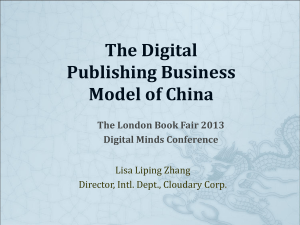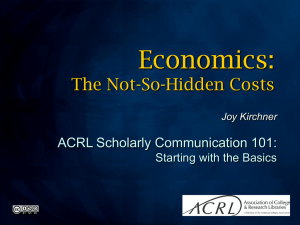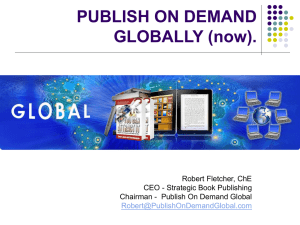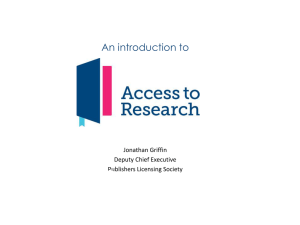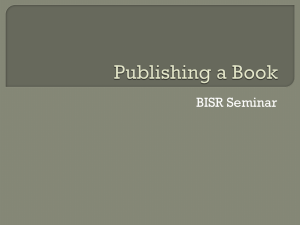Find a reputable OA publisher * Directory of
advertisement
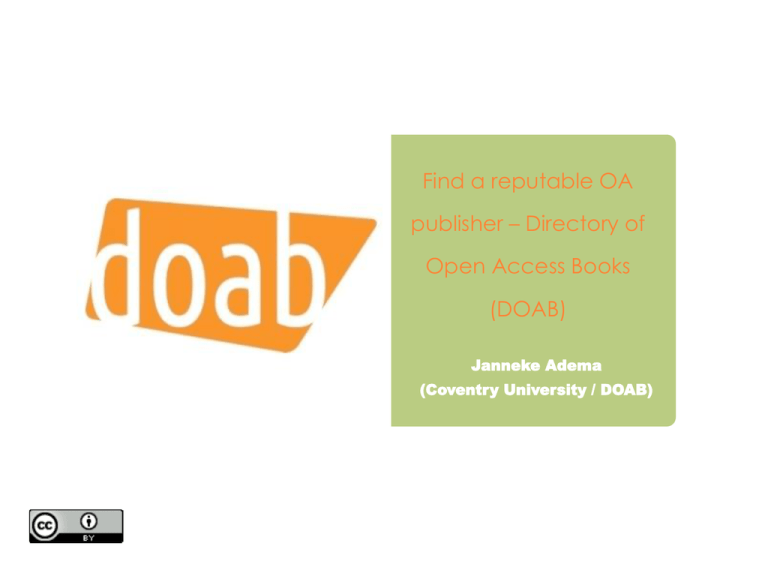
Find a reputable OA publisher – Directory of Open Access Books (DOAB) Janneke Adema (Coventry University / DOAB) Outline Vanity publishing and predatory publishers Quality and Open Access New forms of quality control Directory of Open Access Books Quality requirements and policies Checklists and resources Preventing vanity publishing ‘A vanity press or vanity publisher is a term describing a publishing house in which authors pay to have their books published’ (Wikipedia) But what about Gold Open Access publishing models and APCs? Quality control and editorial services ‘The explosion in open-access publishing has fuelled the rise of questionable operators.’ (Nature, 27 March 2013) Dear Janneke Adema, I am writing on behalf of an international publishing house, LAP Lambert Academic Publishing. In the course of a research on the Coventry University, I came across a reference to your thesis on "Influence of online information transmission on research practices within the Humanities?". We are an international publisher whose aim is to make academic research available to a wider audience. LAP would be especially interested in publishing your dissertation in the form of a printed book. Your reply including an e-mail address to which I can send an e-mail with further information in an attachment will be greatly appreciated. I look forward to hearing from you. Acquisition Editor LAP LAMBERT Academic Publishing GmbH & Co. KG Dudweiler Landstraße 99 66123 Saarbrücken Germany Fon +49 681 3720-310 Fax +49 681 3720-3109 www.lap-publishing.com Predatory Publishers - Jeffrey Beal “Potential, possible or probable predatory scholarly open-access publishers” http://scholarlyoa.com/publishers/ “An intention to deceive authors and readers, and a lack of transparency in their operations and processes” (Beal, Nature, 27 March 2013) Critique of Beal’s methods Predatory OA book publishers? Buyer beware: A checklist to identify reputable publishers - Declan Butler (Nature) How to perform due diligence before submitting to a journal or publisher: Check that the publisher provides full, verifiable contact information, including address, on the journal site. Be cautious of those that provide only web contact forms. Check that a journal's editorial board lists recognized experts with full affiliations. Contact some of them and ask about their experience with the journal or publisher. Check that the journal prominently displays its policy for author fees. Be wary of e-mail invitations to submit to journals or to become editorial board members. Read some of the journal's published articles and assess their quality. Contact past authors to ask about their experience. Check that a journal's peer-review process is clearly described and try to confirm that a claimed impact factor is correct. Find out whether the journal is a member of an industry association that vets its members, such as the Directory of Open Access Journals (www.doaj.org) or the Open Access Scholarly Publishers Association (www.oaspa.org). Use common sense, as you would when shopping online: if something looks fishy, proceed with caution. Quality and Open Access Open Access books are just as qualitative and trustworthy as print publications Misunderstandings and perceptions OAPEN User Needs Report (2010) “Many researchers still consider electronic-only publications as of the equivalent of publishing something without peer review. Even those who were aware of the fact that electronic-only journals also have full peer reviews were concerned that the people who decide their careers were not (…).” “(…) many researchers feel that the Internet is not a good place to find authoritative material because of the high level of poor quality information.” (25) Open Humanities Press “Our strategy is to create an open access brand that people will trust and which will convey the message that OHP's open access publications are just as intellectually challenging, academically rigorous and professionally produced as books and journals produced by the best commercial publishers.” (Beyond Impact: OA in the Humanities, Sigi Jӧttkandt and Gary Hall, 2007) Alternative forms of quality control Open peer review: peer-to-peer review Post-publication review: comments, reviews Editorial control Who decides on quality control? Academics - Peer Review Preferences (N=48) Directory of Open Access Books www.doabooks.org DOAB user needs research: what kind of quality control? Requirements and standards concerning quality control are warmly welcomed More transparency about procedures used (icon system) As long as these standards remain flexible and open to a variety of quality control mechanisms, from editorial control to open peer review and post publication review Focus should remain on the outcome, not on the procedure used “The standards, requirements and protocols DOAB develops for quality control and licensing should be flexible enough to incorporate change and innovation. At the same time they should be strict enough to ensure quality and trust within the system.” (23) DOAB requirements DOAB determines requirements for participation by publishers, in consultation with the participating publishers and OASPA. The current requirements have been specified by the OAPEN Foundation. The current requirements to take part in DOAB are twofold: Academic books in DOAB shall be available under an Open Access license (such as a Creative Commons license) Academic books in DOAB shall be subjected to independent and external peer review prior to publication The policies and procedures regarding peer review and licensing should be clearly outlined on the publisher web site. More information about these requirements can be found in the Statement on Open Access (Appendix II of the OASPA bylaws). CrossMark to improve quality assurance for Open Access books OAPEN-NL and OAPEN-UK are pleased to announce a new joint project to improve quality assurance for Open Access publications. The project will be exploring the use of CrossMark as a OA awareness tool for OA books by implementing it on a selection of titles within the OAPEN pilot projects. Readers use the service by clicking on the CrossMark logos on PDF or HTML documents, and a status box tells them if the document is current or if updates are available. CrossMark also provides a record box, which can contain other useful information about the document to readers, for example, the usage rights, the peer review process, the publication history, etc. It could also contain information about the research connected to the publication, information about grants or links to connected elements such as research data. Checklist Open Access Book Publishers Peer review procedures Licensing policy (for a detailed description of CC licenses please see the Creative Commons website at http://creativecommons.org/) Business model used Preservation policy Digital formats POD/print possibilities More information/resources http://www.doabooks.org/doab?func=about&uiLanguage= en http://oaspa.org/membership/code-of-conduct/ http://oaspa.org/membership/membership-criteria/ http://openscience.com/resources/how-to-publish-anopen-access-monograph/ http://www.doabooks.org/ http://oad.simmons.edu/oadwiki/Publishers_of_OA_books http://www.doabooks.org/ http://books.openedition.org/ References Janneke Adema, DOAB User Needs Analysis – Final Report (DOAB Project Report) (Amsterdam, 2012). Janneke Adema and Paul Rutten, Digital Monographs in the Humanities and Social Sciences: Report on User Needs (Amsterdam, 2010). Declan Butler, “Investigating Journals: The Dark Side of Publishing,” Nature 495, no. 7442 (March 27, 2013): 433–435, doi:10.1038/495433a. Sigi Jӧttkandt and Gary Hall, “Beyond Impact: OA in the Humanities” (presented at the Open Humanities Press Presentation, Brussels, February 13, 2007).


